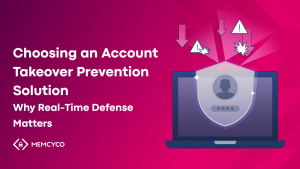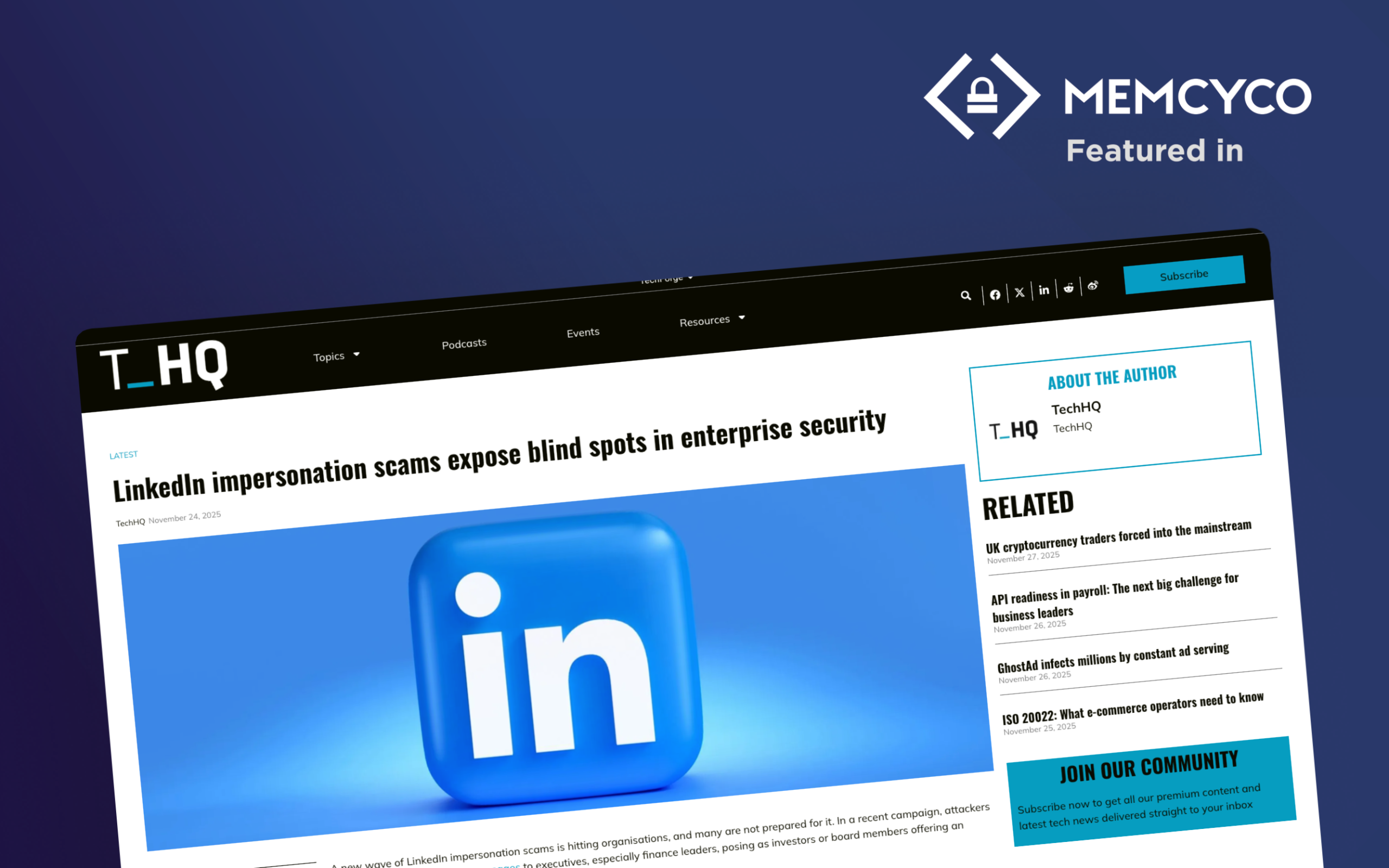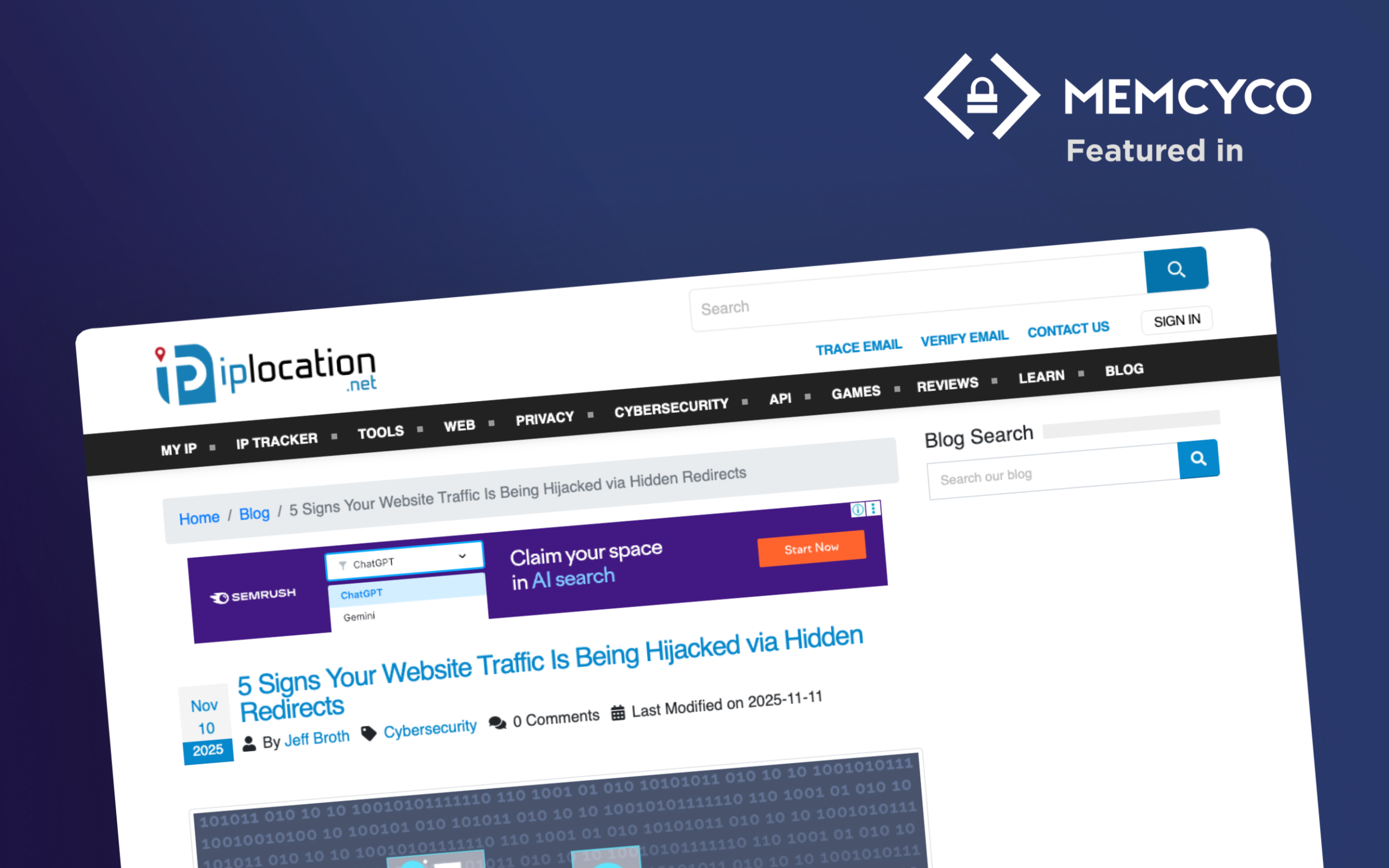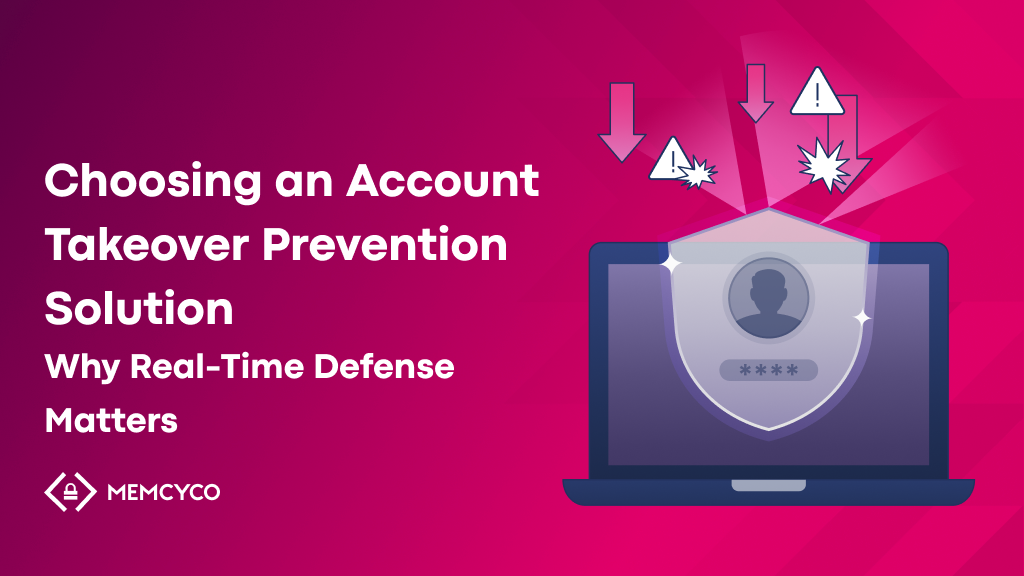Loyalty fraud prevention has become a major industry threat, with loyalty-linked accounts having become digital assets of converging value – storing points, payment credentials, and verified identity data. That makes them irresistible targets for attackers with both the motive and means to exploit them. Phishing, credential stuffing, spoofed login portals, and personalized impersonation scams are just the beginning.
It’s no surprise that loyalty fraud is now the fourth fastest-growing fraud type worldwide, according to the 2024 Global eCommerce Payments and Fraud Report. Estimates about the number of unredeemed loyalty points vary, but the consensus is ‘trillions’, with some sources putting the figure at $48 trillion, back in 2021.
Fraud, risk, and digital teams are taking note, turning to modern approaches that expose potential loyalty fraud preemptively, using pre-login anomaly detection to intercept loyalty account takeover (ATO) attempts before any value is lost.
Before we unpack what that looks like, let’s start with the basics.
What is Loyalty Fraud?
Loyalty fraud (also known as rewards fraud or points fraud) refers to the unauthorized use, transfer, or theft of loyalty points, rewards, or stored value within customer accounts. Fraudsters exploit vulnerabilities in loyalty programs through tactics such as phishing, credential stuffing, fake account creation, account takeover (ATO), social engineering, and insider collusion. These attacks enable criminals to redeem or transfer points, manipulate balances, or abuse promotional offers, causing significant financial loss and reputational damage across industries like retail, airlines, travel, and hospitality. Loyalty fraud often goes undetected for extended periods, making real-time detection and prevention critical.
Common Attack Vectors that Lead to Loyalty Fraud
Loyalty ATO doesn’t rely on just one exploit. To stay ahead of attackers, fraud and risk teams need to look out for a combination of entry points like these:
- Phishing and spoofed domains to trick users into entering login credentials
- Credential stuffing attacks using breached password data to access accounts
- Session hijacking during active login sessions, particularly on public Wi-Fi or mobile devices
- Man-in-the-middle techniques to relay real-time credentials and bypass MFA
By detecting phishing attempts, blocking untrusted devices, and flagging spoofed sessions in real time, security teams can intercept loyalty fraud before attackers redeem points, make purchases, or lock out real users.
Loyalty Program Fraud in Key Industries
Airlines: Loyalty Miles and Ticketing Fraud
Airlines are disproportionately affected by loyalty-linked fraud. According to The International Air Transport Association (IATA).
- Airlines account for nearly 46% of all online fraud transactions, making them the most targeted sector.
- Fraud attacks in the airline industry surged 61% between 2018 and 2019.
- Fraudulent airline ticket purchases average $1,930, over three times the average legitimate ticket value.
- In loyalty programs, 60% of fraud involves points/miles purchased with stolen cards, while 52% stems from loyalty account takeovers.
Attackers use phishing or credential reuse to access accounts, then:
- Redeem miles for resellable tickets or upgrades
- Modify passenger names or itineraries
- Add compromised cards for future purchases
This type of loyalty ATO creates not only financial loss, but also reputational risk when victims blame the airline.
To fully understand the threat landscape, it’s important to look beyond ATO as well.
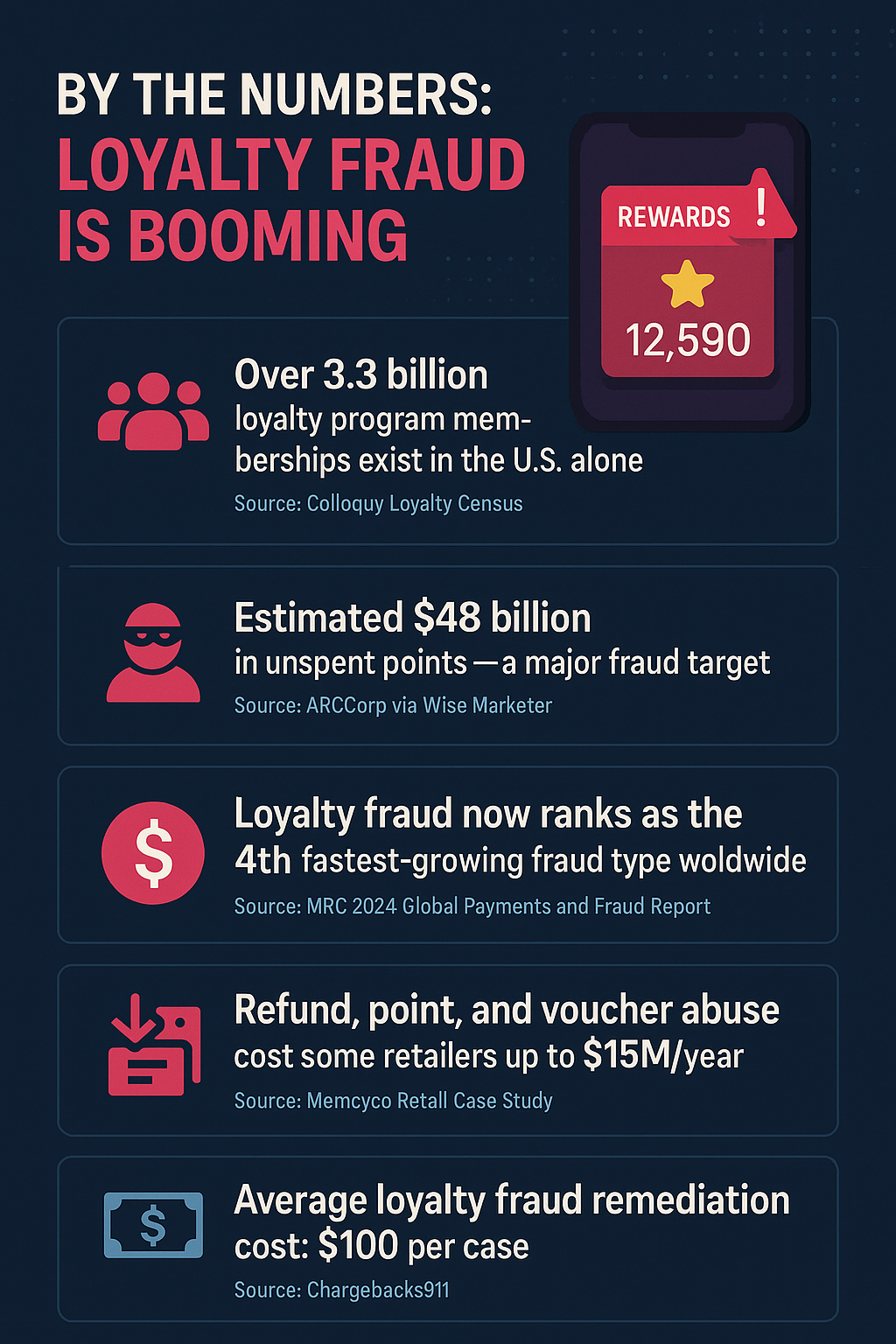
Other Loyalty Fraud Risks in Airlines
- Referral program manipulation
- Promo abuse through multiple fake accounts
- Loyalty point laundering across accounts
- Insider abuse of loyalty systems
These risks exploit various angles of loyalty programs, but most share a common vulnerability – weak control at the point of login or user interaction.
Travel and Hospitality: Stored IDs and Booking Control
Travel and hospitality apps often store verified IDs, travel itineraries, and booking privileges. Threat actors can:
- Spoof mobile apps to harvest login details
- Use stolen credentials to cancel or resell bookings
- Access loyalty-linked perks, such as VIP upgrades or lounge access
These attacks undermine trust and strain customer service teams.
These aren’t the only fraud types facing travel and hospitality teams.
Other Loyalty Fraud Risks in Travel & Hospitality
- Fake signups for welcome bonuses
- Automated abuse of VIP upgrade systems
- Self-referral in loyalty-linked promotions
- Misuse of stored loyalty credentials across apps
While not all involve account takeovers, many of these fraud types start with access that could have been flagged or blocked earlier.
Retail and eCommerce: Payment Credential Theft and Rewards Fraud
Retail loyalty programs increasingly store:
- Saved credit card or digital wallet data
- Redeemable assets frequently targeted in loyalty points fraud
- Exclusive discounts and promotional codes
- Tier-based benefits and reward balances
Once an attacker gains access, they can:
- Extract payment details
- Abuse reward codes or gift balances
- Change account information to lock out real users
Credential stuffing is particularly rampant in this sector because of password reuse and weak authentication.
Case Study: Memcyco Helps Global Retailer Save $5M by Blocking Loyalty Voucher Scams
One international supermarket chain operating in over 50 countries faced persistent loyalty-related scams involving fake voucher websites. These sites tricked customers into sharing login details or making purchases, leading to a spike in reimbursement claims and incident-handling costs. With 150,000 fake gift card attempts per year – each costing an estimated $100 to resolve – the company faced nearly $15 million in annual exposure.
After deploying Memcyco’s real-time ATO, phishing and digital impersonation protection, the company saw a sharp drop in scam conversions and saved approximately $5 million per year in fraud-related costs. By detecting traffic from spoofed voucher sites and auto-swapping at-risk user credentials with Memcyco’s Decoy Credentials, the retailer was able to neutralize scams mid-session before customer accounts or loyalty balances were compromised.
Loyalty fraud in retail often extends well beyond account takeovers.
Other Loyalty Fraud Risks in Retail
- Coupon abuse and discount brute-forcing
- Mass fake account creation for rewards harvesting
- Loyalty code resale and promotion stacking
- Device-based referral abuse tactics
These tactics often fly under the radar of traditional monitoring, but all can originate from the same root problem: visibility gaps at the point of fraud entry.
Why Traditional Controls Fall Short
Most organizations rely on post-login defenses such as suspicious login alerts, fraud scoring, or delayed transaction review. In loyalty ATO, however, fraud happens fast:
- Stolen points or rewards are cashed out instantly
- Bookings are modified in seconds
- Card data is extracted before alerts trigger
By the time downstream systems flag an issue, the damage is done.
Take a typical scenario: a user redeems 80,000 miles for a last-minute upgrade at 3 a.m., just minutes after logging in from a flagged device overseas. Without visibility into high-risk sessions as they begin, that redemption goes through – and recovery options vanish.
Proactive Loyalty Fraud Prevention Tactics That Work
Key Signals That Indicate Loyalty Fraud in Progress
Security teams looking to proactively identify loyalty fraud should monitor for patterns such as:
- Device inconsistency – New or untrusted devices accessing multiple accounts across campaigns
- Session timing anomalies – Access attempts during non-standard hours or too-quick re-entry
- Geolocation mismatches – Impossible travel scenarios across login attempts
- Referral or traffic source anomalies – Users arriving from spoofed domains or low-reputation referrals
- Credential replay behavior – Reuse of stolen credentials across sessions or accounts, indicating automated or scripted attack attempts
- Reused infrastructure – Repeat use of same device ID or IP block across multiple fraud types
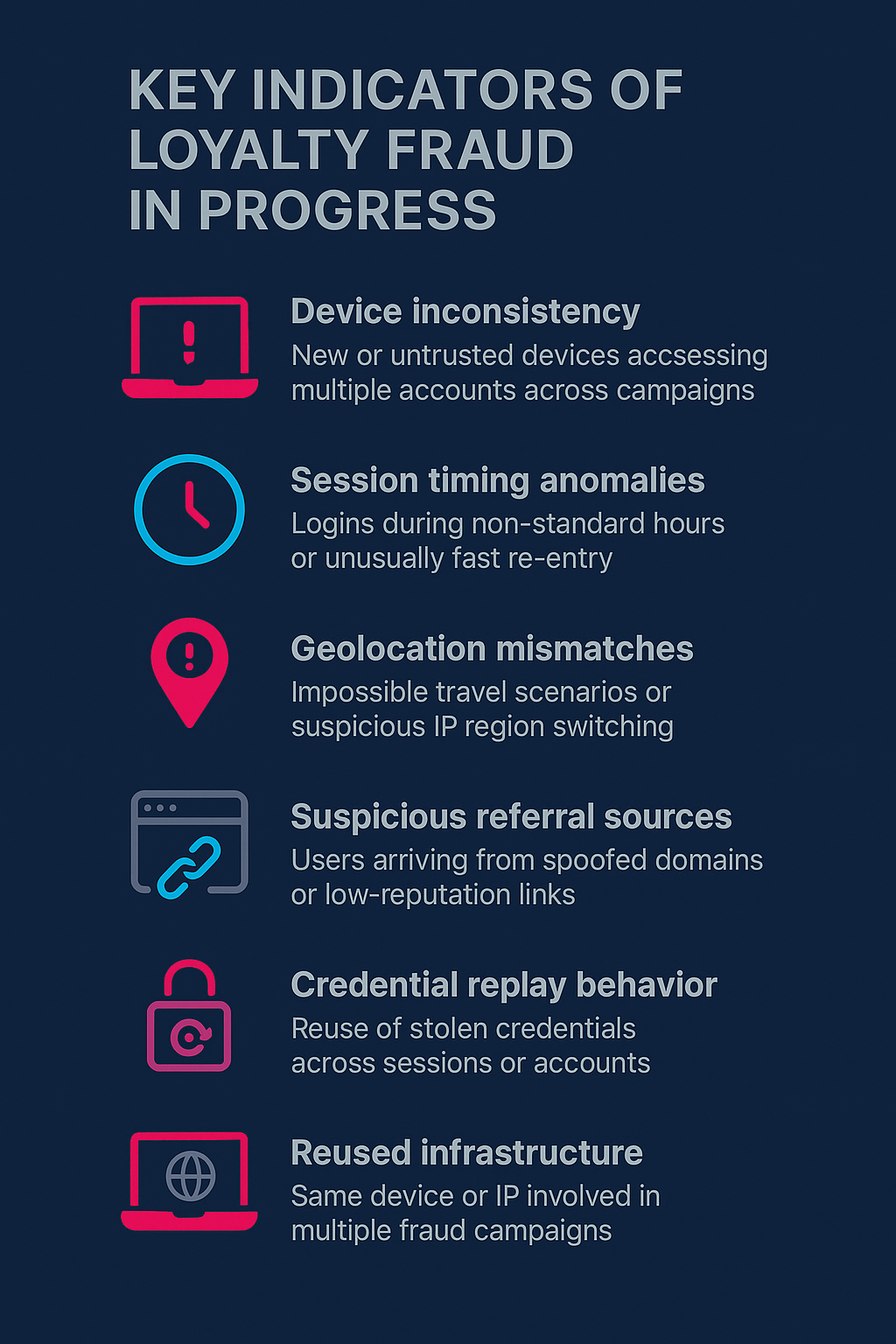
Spot loyalty fraud as it happens. From device inconsistency to credential replay, these six real-time signals can help security teams detect and intercept loyalty ATOs before value is lost.
These signals are most effective when evaluated in real time using session-based telemetry, credential use patterns, and spoofed session identification.
To prevent loyalty fraud before value is lost, security teams are increasingly combining layered authentication, behavioral device analysis, and real-time session monitoring. The most effective programs include early phishing detection, automatic credential decoys, and real-time visibility into suspicious devices. When these measures work together, loyalty fraud prevention becomes proactive rather than reactive, closing the window between attack attempt and response.
How Memcyco Helps Prevent Loyalty Scams in Real Time
Memcyco’s digital impersonation, phishing and ATO solution infiltrates attacks from their inception, deploying real-time measures at every stage of the attack timeline. Book a product tour and discover the secret-sauce technologies helping Memcyco customers reduce incident-related opex by tens of millions annually.
Real-Time Phishing Detection and Spoof Site Blocking
This real-time protection detects when users arrive from spoofed domains, fake apps, or impersonated social profiles and stops high-risk sessions before login occurs. Instead of relying on static threat feeds or user reports, it detects threat signals based on referral patterns, behavioral anomalies, and deception tactics. This allows Memcyco to block loyalty ATO attempts in progress, before attackers can exploit credentials or reach stored value.
Decoy Credentials and Decoy Card Data Injection
Memcyco’s decoy credential technology replaces credentials – entered by users on fake sites – with fake yet realistic data fraudsters will assume are legitimate credentials. When attackers collect this decoy data and try to use it for loyalty ATO, they’re instantly locked out and the security team is alerted of the attempt, plus the victim’s identity. This makes the approach highly effective at trapping fraudsters and preventing the use of stolen login or card data at scale, and reducing the impact of loyalty ATO fraud across your user base.
Suspicious Device Identification and Blocking
This approach to device intelligence goes beyond fingerprinting. It builds behavioral context over time, marking devices as suspicious not only based on configuration, but also on their role in phishing journeys, credential stuffing attempts, or impersonation behavior. Devices flagged in one fraud event can be blocked from accessing any protected asset, even across campaigns or business units.
Session Anomaly Detection
Each session is evaluated for signs of fraud such as geographic mismatches, login pattern anomalies, or high-risk device behavior. When suspicious access attempts are detected, the system can block or flag sessions in real time before login is completed or credentials are misused.
Real-Time Victim Visibility and Fraud Disruption
This capability enables precise fraud response by surfacing real-time indicators of who is being targeted, how, by which devices, and through which spoofing vectors. Every ATO attempt is linked to session-level metadata, helping you take immediate action, lock out bad actors, contact affected users, and feed intelligence into your broader fraud systems. This closes the gap between attack detection and response, improving recovery outcomes.
Unlike forensic tools that act too late, this protection activates when it matters most, during the actual attack.
FAQs
How can loyalty fraud prevention start before login?
Loyalty fraud prevention begins by identifying and intercepting threats before credentials are ever used. This includes detecting spoofed domains, injecting decoy credentials when phishing sites attempt to capture data, and flagging suspicious session behavior. Stopping ATO attempts at this early stage prevents exploitation of loyalty-linked value.
What is loyalty program fraud?
Loyalty program fraud is the theft or abuse of rewards points, stored payment data, or perks within a loyalty-linked account. Attackers use phishing, credential stuffing, or spoofed sites to gain access and exploit value.
How can loyalty programs prevent ATO fraud?
ATO prevention requires more than login security. Organisations should deploy real-time detection of spoofed sites, decoy data injection, and live session anomaly monitoring to block fraud before account access is completed. These measures form the core of loyalty fraud prevention at scale.
Why are retail accounts so vulnerable to takeover?
Retail loyalty accounts often store payment information, points, and discounts, making them appealing to attackers. Password reuse and weak MFA increase the risk of credential stuffing and phishing-based compromise.
How does Memcyco help stop loyalty program fraud?
Memcyco preempts ATO, blocks spoofed sites, injects decoy credentials, identifies suspicious devices, detects session anomalies, and provides victim-level visibility, all in real time, before value is lost. Together, these capabilities deliver proactive loyalty fraud prevention that closes gaps left by scanning and takedown services or even modern threat intelligence solutions.
Is credential stuffing common in loyalty account fraud?
Yes. Credential stuffing is a primary vector in loyalty ATOs. Attackers test stolen credentials en masse, exploiting reused passwords to access high-value loyalty accounts.







